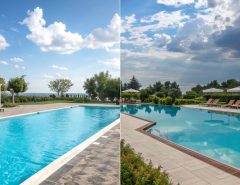Installing an above ground pool in your backyard can be an exciting and rewarding project. However, proper installation and leveling of the pool is crucial for functionality, safety, and longevity. An uneven pool base can cause structural issues over time and create unstable walls or floors. Thankfully, there are some easy DIY above ground pool leveling hacks you can use to get yourpool properly leveled even if you’re working on unlevel ground.
Assess the Pool Location
Before starting any leveling, walk around the intended pool area and take note of any slopes, hills, or uneven spots. Use a level tool on the ground in several areas to identify high and low points. Mark particularly unlevel areas with spray paint or colored stakes.
You’ll need to account for these gradual slopes when leveling – sometimes it’s impossible to get the entire area perfectly flat. Focus on getting the inside pool floor as level as possible, even if the outside pool walls end up slightly angled.
Use Sand or Gravel to Fill Low Spots
One of the easiest ways to level ground for an above ground pool is by using sand or gravel. Shovel coarse builder’s sand or pea gravel into any visibly low spots. Compact the material by hand or with a hand tamper.
Repeat this process until low areas are built up to be flush with higher points. Add only an inch or two of material at a time to avoid overfilling. The final pool area should be as close to perfectly flat and level as possible.
Make Gradual Slopes More Level

Sometimes the pool location has a gradual, barely noticeable slope rather than defined low spots. One DIY trick for leveling minor slopes is to make a “sand pizza.”
Cut rounds from plywood just wider than your pool diameter. Place the wooden circle where the pool will go and trace the outline. Fill just the circle area with 1-2 inches of sand and use a long board to smooth it flat. This effectively creates a flat platform on the angled ground.
Use Shims Under the Pool Walls
Shim stacks are another easy way to manually adjust for unlevel ground when assembling the pool. Use 1/8″ or 1/4″ thick plastic or composite shims around the base of pool walls that settle lower than others.
Layer multiple shims if needed – most pool walls have some wiggle room at ground level to lift low spots 1-2 inches. Stagger the shims for stability and check with a level frequently during assembly.
Check for Level Frequently
It’s critical to use a 4-foot level tool often during the pool assembly process. Recheck the level after preparing the ground, laying bottom tracks, assembling pool walls, and adding water.
Make any needed adjustments right away – trying to level an already full pool is extremely difficult. Don’t be afraid to disassemble partly and try again if the floor or walls end up off. Patience and frequent level checks are key for DIY pool leveling.
Useful Tools and Materials for Leveling
Having the right gear makes leveling an above ground pool much simpler. Here are some must-have tools and supplies:
- 4-Foot Level – Essential for checking level frequently during assembly. Get an accurate model with bubble vials on at least 3 sides.
- Line Level – Also called a “torpedo level.” Useful for checking level around pool wall exteriors.
- Hand Tamper – Compacts sand, gravel, and other fill efficiently. Speeds up leveling ground.
- Measuring Tape – Important for laying out the pool area and making sure it’s square.
- Marking Paint/Stakes – Help mark slope issues and outline the pool for leveling fill inside the footprint.
- Sand and Gravel – Use clean fill materials to raise low areas of the pool site. Compacts well when leveled.
- 1/4″ and 1/8″ Shims – Place under pool wall base tracks to manually adjust level during assembly. Stack in layers as needed.
- Scrap Plywood – Make round “platforms” to create flat spots on gradually sloped ground.
Having these simple, inexpensive tools on hand makes luxury pool leveling much more manageable. Don’t skip the necessary supplies – trying to level just with your eyes or a small carpenter’s level never ends well!
Step-By-Step Pool Leveling Process
Once you understand the basics, here is a step-by-step process for leveling above ground pool installations:
- Use stakes and marking paint to identify obviously high and low areas in the pool site.
- Build up low spots gradually using compacted fill material like sand or gravel.
- Use a “sand pizza” or other technique to flatten minor slopes.
- Lay out the bottom tracks and buttresses per the pool instructions. Check for level frequently and adjust as needed.
- Assemble the pool walls according to the manufacturer’s directions, checking level every few courses.
- Place shims under base plates or bottom rails as needed to adjust for unlevel wall sections.
- Follow all instructions for attaching top rails, skimmers, etc. Recheck level when finished.
- Fill the pool halfway and check for level one last time before completing the fill.
- Enjoy your perfectly leveled above ground pool! Make adjustments next season if any spots settle over winter.
Careful preparation, patience, and frequent level checks at each stage help ensure proper installation and a pool that holds water accurately. Don’t skip corners – an unlevel pool can be a huge, expensive headache down the road.
Helpful Tips and Precautions

To wrap up, here are some additional useful tips and precautions when leveling above ground pools:
- Work slowly and carefully. There’s no rushing proper leveling procedures.
- Consider renting laser or optical levels for extreme sloping sites – they make it easier to identify gradients.
- Lift and reposition walls or panels rather than adding excessive shims which can destabilize walls.
- Check for plumb as well as level – walls leaning outward put stress on sidewalls and joints.
- Don’t burrow shims and stabilizers in soil – they can shift and settle over time.
- Avoid tamping or compacting ground right next to assembled pool – it can dent and distort the walls.
- Check with your pool manufacturer for any specific leveling recommendations or requirements before starting.
- Have patience and take your time – slight adjustments at each stage makes leveling easier in the end.
Proper preparation and planning truly pays off when installing and leveling above ground pools. With some DIY know-how and the right tools, you can handle this crucial task and end up with a beautiful and functional pool for years of backyard fun. Just stay calm, work methodically, and of course, keep checking that level!
Conclusion
Leveling the soil and constructing the pool properly is one of the most vital parts of above ground pool installation. It may take careful preparation and patience, but getting the site flat and the pool floor level helps the structure withstand years of use. With compacted fill material, frequent level checks, and some adjusting shims, you can DIY a perfectly leveled above ground pool. Just work slowly, follow above ground pool leveling hacks, and don’t be afraid to take panels apart and try again if something is off. With the right tools and commitment to careful leveling, you’ll soon be relaxing poolside!
FAQs
Q: How much slope is acceptable for an above ground pool floor?
A: Most manufacturers recommend no more than a 1-2 inch slope across the entire pool floor. Any more than that can put stress on the structure.
Q: Should I use sand or gravel to level the ground under my pool?
A: Clean sand or pea gravel are both good options for filling low spots and leveling the soil. Just compact in layers 1-2 inches thick.
Q: What’s the easiest way to level a pool on a concrete patio or deck?
A: Use wooden shims and foam pool leveling blocks under the wall base plates as needed to adjust for any slope in the patio surface.
Q: Is it okay if my above ground pool walls are not quite vertical?
A: Yes, the walls do not have to be perfectly plumb as long as the pool structure is sturdy and not leaning excessively at the top.
Q: How often should I check for level when assembling my above ground pool?
A: Check level every 2-3 courses of wall panels as you assemble them. It’s much easier to make adjustments as you go rather than at the end.
Tags: above ground pool leveling, above ground pool leveling ideas, above ground pool leveling kit, above ground pool leveling problems, above ground pool leveling service, above ground pool leveling service near me



